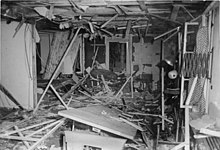On 22 June 1941, three million German troops attacked the Soviet Union, breaking the non-aggression pact Hitler had concluded with Stalin two years earlier. This invasion seized huge amounts of territory, including the Baltic states, Belarus, and Ukraine. It also encircled and destroyed many Soviet forces, which Stalin had ordered not to retreat. However, the Germans were stopped barely short of Moscow in December 1941 by the Russian Winter and fierce Soviet resistance. The invasion failed to achieve the quick triumph Hitler wanted.
A major historical dispute concerns Hitler's reasons for Operation Barbarossa. Some historians such as Andreas Hillgruber have argued that Barbarossa was merely one "stage" of Hitler's Stufenplan (stage by stage plan) for world conquest, which Hillgruber believed that Hitler had formulated in the 1920s. Other historians such as John Lukacs have contended that Hitler never had a stufenplan, and that the invasion of the Soviet Union was an ad hoc move on the part of Hitler due to Britain's refusal to surrender. Lukacs has argued that the reason Hitler gave in private for Barbarossa, namely that Winston Churchill held out the hope that the Soviet Union might enter the war on the Allied side, and that the only way of forcing a British surrender was to eliminate that hope, was indeed Hitler's real reason for Barbarossa. In Lukacs's perspective, Barbarossa was thus primarily an anti-British move on the part of Hitler intended to force Britain to sue for peace by destroying her only hope of victory rather than an anti-Soviet move. Klaus Hildebrand has maintained that Stalin and Hitler were independently planning to attack each other in 1941. Hildebrand has claimed that the news in the spring of 1941 of Soviet troop concentrations on the border led to Hitler engaging in a flucht nach vorn ("flight forward" – i.e. responding to a danger by charging on rather than retreating.) A third faction comprising a diverse group such as Viktor Suvorov, Ernst Topitsch, Joachim Hoffmann, Ernst Nolte, and David Irving have argued that the official reason given by the Germans for Barbarossa in 1941 was the real reason, namely that Barbarossa was a "preventive war" forced on Hitler to avert an impeding Soviet attack scheduled for July 1941. This theory has been widely attacked as erroneous; the American historian Gerhard Weinberg once compared the advocates of the preventive war theory to believers in "fairy tales"
The Nazi invasion of the Soviet Union reached its apex on 2 December 1941 as part of the 258th Infantry Division advanced to within 15 miles (24 km) of Moscow, close enough to see the spires of the Kremlin, but they were not prepared for the harsh conditions brought on by the first blizzards of winter and in the days that followed, Soviet forces drove them back over 320 kilometres (200 miles).
On 7 December 1941, Japan attacked Pearl Harbor, Hawaii, and four days later, Hitler's formal declaration of war against the United States officially engaged him in war against a coalition that included the world's largest empire (the British Empire), the world's greatest industrial and financial power (the United States), and the world's largest army (the Soviet Union).
On 18 December 1941, the appointment book of the Reichsführer-SS Heinrich Himmler shows he met with Hitler, and in response to Himmler's question "What to do with the Jews of Russia?", Hitler's response was recorded as "als Partisanen auszurotten" ("exterminate them as partisans"). The Israeli historian Yehuda Bauer has commented that the remark is probably as close as historians will ever get to a definitive order from Hitler for the genocide carried out during the Holocaust.
In late 1942, German forces were defeated in the second battle of El Alamein, thwarting Hitler's plans to seize the Suez Canal and the Middle East. In February 1943, theBattle of Stalingrad ended with the destruction of the German 6th Army. Thereafter came the Battle of Kursk. Hitler's military judgment became increasingly erratic, and Germany's military and economic position deteriorated along with Hitler's health, as indicated by his left hand's severe trembling. Hitler's biographer Ian Kershaw and others believe that he may have suffered from Parkinson's disease. Syphilis has also been suspected as a cause of at least some of his symptoms, although the evidence is slight.
Following the allied invasion of Sicily (Operation Husky) in 1943, Mussolini was deposed by Pietro Badoglio, who surrendered to the Allies. Throughout 1943 and 1944, the Soviet Union steadily forced Hitler's armies into retreat along the Eastern Front. On 6 June 1944, the Western Allied armies landed in northern France in what was one of the largest amphibious operations in history, Operation Overlord. Realists in the German army knew defeat was inevitable, and some plotted to remove Hitler from power.
Attempted assassination
There were numerous attempts or ideas by private individuals, organisations or states wishing to assassinate Hitler. Some of the plans proceeded to significant degrees. While some attempts occurred before World War II, the most famous attempt came from within Germany. The plan was at least partly driven by the prospect of the increasingly imminent defeat of Germany in the war.
In July 1944, as part of Operation Valkyrie in what became known as the 20 July plot, Claus von Stauffenberg planted a bomb in Hitler's headquarters, the Wolfsschanze(Wolf's Lair) at Rastenburg. Hitler narrowly escaped death due to random chance, as someone unknowingly moved the briefcase that contained a bomb by pushing it behind a leg of the heavy conference table. When the bomb exploded, the table subsequently deflected much of the blast away from Hitler. Later, Hitler ordered savage reprisals, resulting in the executions of more than 4,900 people, sometimes by starvation in solitary confinement followed by slow strangulation. The main resistance movement was destroyed, although smaller isolated groups continued to operate.


No comments:
Post a Comment